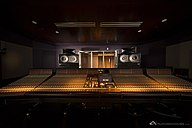Audio mi xing
Audio mi xingis the process by which multiple sounds are combined into one or moreaudio channels.In the process, a source's volume level,frequency content,dynamics,andpanoramic positionare manipulated or enhanced. This practical, aesthetic, or otherwise creative treatment is done in order to produce a finished version that is appealing to listeners.
Audio mi xing is practiced for music, film, television and live sound. The process is generally carried out by ami xing engineeroperating ami xing consoleordigital audio workstation.
Recorded music
[edit]Before the introduction ofmultitrack recording,all the sounds and effects that were to be part of a recording were mixed together at one time during a live performance. If the sound blend was not satisfactory, or if one musician made a mistake, the selection had to be performed over until the desired balance and performance was obtained. However, with the introduction of multitrack recording, the production phase of a modern recording has radically changed into one that generally involves three stages: recording,overdubbing,and mixdown.[1]
Film and television
[edit]
During production dialogue recording of actors is done by a person variously known as location sound mixer, production sound or some similar designation. That person is a department head with a crew consisting of a boom operator and sometimes a cable person.
Audio mi xing for film and television is a process during thepost-productionstage of amoving imageprogram by which a multitude of recorded sounds are combined. In the editing process, the source's signal level, frequency content, dynamics, and panoramic position are commonly manipulated and effects added. In video production, this is called sweetening.
The process takes place on a mi xing stage, typically in astudioor purpose-builttheater,once the picture elements are edited into a final version. Normally the engineers will mix four main audio elements called stems: speech (dialogue,ADR,voice-overs,etc.),ambience(or atmosphere),sound effects,and music. As multi machine synchronization became available, filmmakers were able to split elements into multiple reels. With the advent of digital workstations and growing complexity, track counts in excess of 100 became common.
Dialogue intelligibility
[edit]Since the 2010s, critics and members of the audience have reported that dialogue in films tends to be increasingly more difficult to understand than in older films, to the point where viewers need to rely onsubtitlesto understand what is being said. Ben Pearson ofSlashFilmattributed this to a combination of factors, only some of which can be addressed through audio mi xing:[2]
- Unintelligibility as a stylistic choice by filmmakers, particularly byChristopher Nolanand those influenced by him
- Soft, under one's breath delivery of lines by actors, a practice particularly popular among younger actors, as opposed to the theatrical clarity of delivery previously used
- Low priority of sound recording on set, with priority given to the visual aspects of production
- Increased technological possibilities, including in post-production, no longer compel filmmakers to obtain an optimal recording on set
- The film crew's familiarity with the dialogue can lead them to overestimate its intelligibility
- Theaters play films at a lower than recommended volume to avoid excessive loudness complaints from the audience
- Different standards of compression and volume balance applied by the variousstreaming platforms
- Inadequate audio remi xing for films played in ahome theatersetting or on mobile devices, where the audio playback capabilities of the various setups strongly differ from each other and from cinema settings
Live sound
[edit]
Live sound mi xingis the process of electrically blending together multiple sound sources at a live event using ami xing console.Sounds used include those from instruments, voices, and pre-recorded material. Individual sources may beequalisedand routed toeffect processorsto ultimately beamplifiedand reproduced vialoudspeakers.[3]The live sound engineer balances the various audio sources in a way that best suits the needs of the event.[4]
References
[edit]- ^Huber, David Miles (2001).Modern Recording Techniques.Focal Press. p.321.ISBN0-240-80456-2.
- ^Pearson, Ben (2021-11-30)."Here's Why Movie Dialogue Has Gotten More Difficult To Understand (And Three Ways To Fix It)".SlashFilm.Retrieved2021-12-06.
- ^"Mi xing Principles".Leonard Audio Institute.Retrieved2013-01-03.
- ^Tim Crosby (28 April 2008)."How Live Sound Engineering Works".HowStuffWorks.Retrieved2013-03-03.
Further reading
[edit]- Rose, Jay,Producing Great Sound for Film and Video.Focal Press, fourth edition 2014 Book info.ISBN978-0-415-72207-0
- Davis, G. and Davis, G.D. and Jones, R. and Corporation, Y.I. (1989).The Sound Reinforcement Handbook.Recording and Audio Technology Series. Hal Leonard.ISBN9780881889000.
{{cite book}}:CS1 maint: multiple names: authors list (link) - Izhaki, R. (2013).Mi xing Audio: Concepts, Practices and Tools.Taylor & Francis.ISBN9781136114229.




